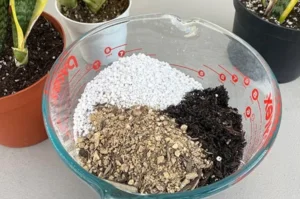If you’ve got a snake plant sitting pretty in your room, chances are you’ve wondered if you can give it a little “extra love” by watering it with milk. Maybe you heard someone say milk is good for plants, or maybe you’re just experimenting a bit.
But here’s the thing while it might sound like a good idea, snake plants and milk don’t really mix well.
Let’s break it down in a simple, no-jargon way.
So… Can You Water Snake Plants With Milk?
Technically, yes — you can. But should you? Not really.
Milk has calcium, protein, and sugars. All things our bodies love — but for plants, not so much.
When you pour milk into your snake plant’s soil, a few not-so-fun things can happen:
- The milk spoils in the soil and starts to smell bad (like sour yogurt, yuck).
- It attracts bugs like ants, gnats, and even mold.
- It messes with the air flow in the soil, which can lead to root rot.
- The sugar in milk can feed harmful bacteria in the soil.
Snake plants like their roots dry and their care routine simple. When we introduce weird stuff like milk, we’re usually doing more harm than good, even with good intentions.
Do Snake Plants Get Any Benefit From Milk?
Short answer? Nope.
Snake plants don’t need milk to grow. They aren’t calcium-deficient, they don’t crave protein, and they certainly don’t need sugar.
Here’s a quick look at what’s in milk vs what a snake plant actually wants:
| What’s in Milk | Is It Helpful? | Why Not? |
| Calcium | Not needed | Soil usually has enough for snake plants |
| Protein & Fats | No | Not something roots can absorb |
| Sugars (Lactose) | Nope! | Leads to rot, pests, and bacteria |
| Water (in milk) | Kind of | But mixed with all the wrong stuff |
Basically, milk is for cereal, not for snake plants.
What About Diluted Milk?
Some gardeners use diluted milk on veggies like tomatoes as a natural way to treat fungus or boost calcium. But even then, it’s done carefully, and usually sprayed on the leaves, not poured into the soil.
But for indoor plants like your snake plant? Even diluted milk can backfire.
It’s just not worth the risk.
What Should You Use Instead?
Great question! Here’s what your snake plant loves:
- Bright, indirect light (but it can survive in low light too)
- Infrequent watering once every 2 to 3 weeks is perfect
- Well-draining soil (a cactus or succulent mix works great)
- A basic houseplant fertilizer every few months (during spring and summer)
If you want to give your plant a little boost, go with a balanced liquid fertilizer (not milk from your fridge).
Common Mistakes to Avoid
A lot of us love our plants a little too much, and that’s where we get in trouble. Here are a few things to steer clear of:
- Overwatering, the #1 killer of snake plants
- Using milk, rice water, or other kitchen hacks that mess with the soil
- Keeping the plant in a pot with no drainage holes
- Putting it in harsh, direct sunlight for long hours
Just remember: simple care is the best care.
Final Thoughts: Keep It Natural
At the end of the day, your snake plant doesn’t need fancy tricks to thrive. No milk, no banana peels, no eggshell water.
Just give it:
- the right amount of light,
- a little water every couple of weeks,
- and some well-draining, nutrient-rich succulent soil like this one to help it thrive without the drama.
That’s all it needs.
Think of your snake plant like a chill friend (it doesn’t ask for much), but it appreciates the little things you do right.
Frequently Asked Questions (FAQs):
Can I spray milk on my snake plant leaves?
Not a good idea. It can leave spots and attract pests.
What can I use instead of milk for plant growth?
A balanced houseplant fertilizer or compost is way better.
Is spoiled milk good for plants?
Not for snake plants. It can cause root rot and smells bad.






